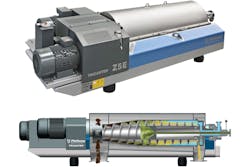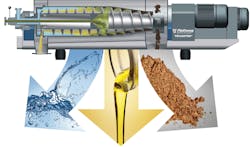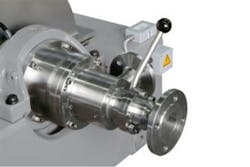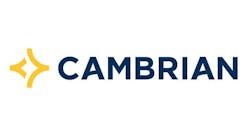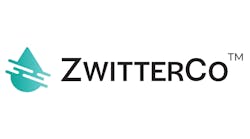Centrifuge system streamlines wastewater treatment at packaged meat facility
A packaged meat production company in the Midwest made a decision four years ago to switch from two separation machines to one that could do the work of two in its wastewater treatment plant. The new machine, along with its other operations, allowed the facility to have zero waste from the 16,000 animals that are processed each day at the plant.
Background: Packaged meat production process
Every head of hog has excess fat. First, the useable meat (for example, ham, sausage, pork bellies and tenderloin) is harvested and sold to the consumer for human consumption and for other purposes such as pet food, industrial, medical and biodiesel.
The leftover parts that are not for human consumption — like the fat, the skin and other parts of the animal — are all used. Therefore, nothing is wasted and nothing goes to landfill. The bones are ground into bone meal. The skin and parts of the head are ground into protein meal, which is a primary ingredient in pet food.
Some plants will cook the remaining organic material and use dissolved air flotation (DAF) systems to float the fats, oils and grease to the surface of a pool. This would then be taken to neighboring farms and spread on soil for fertility, which is good for earthworms and other organisms because it contains healthy bacteria. However, this practice is less common because of U.S. Environmental Protection Agency (EPA) regulations, and it is one of the reasons some processing plants are installing three-phase separation technology.
In three-phase separation, it is possible to
separate two liquid phases from one solid phase at the same time.
The challenge
Four years ago, the packaged meat company was using a decanter centrifuge to separate the solids from liquids coming from a DAF unit. The solids were sent to a raw bin, and the leftover water and oil mixture was then run through a disc stack separator, which separated the oil and the water. Two machines required twice the labor and twice the maintenance, so these systems required optimization.
The solution
The company installed a Flottweg Tricanter, a centrifuge system that can handle the work of both of the previous two machines, saving time, space, energy, maintenance and costs.
The DAF sludge is typically 10% fat, 10% solids and 80% water. The Tricanter can extract the 10% fat and use it for biodiesel fuel, the solids are separated via the same machine and sent to the rendering plant for pet food and the water remains inside the system for further processing. Rather than sending material to land applications, which requires special equipment, the material is processed.
In contrast to a two-phase process, product can be separated into water, oil and grease with one machine.
How it works
In three-phase separation, two liquid phases can be separated from one solid phase at the same time. The Tricanter can separate these three phases. The different densities of the (immiscible) liquids and the solids means that all three phases can be discharged simultaneously.
To ensure the separation process can take place, the solid phase must be the heaviest phase and the liquid phases must have different densities. Otherwise, the scroll of the decanter will not transport the solid at all, or only inadequately, which affects the separation result.
The structure and function of the Tricanter are similar to those of a decanter (two-phase separation). The decisive difference between the two machines is the way the liquid is discharged. There are two liquid phases in a Tricanter — a "heavy" liquid phase (higher density and discharged under pressure) and a "light" liquid phase (lower density and discharged without pressure).
An adjustable impeller discharges the heavy liquid phase. The operator can use the adjustable impeller to adjust the pond depth of the heavy liquid without difficulty during ongoing operation. An adjustment mechanism causes the position of the impeller to change, thereby changing the separation line of the liquids. The process results can be influenced to achieve the required separation result. Most three-phase separation machines require disassembly to change the weir ring, which sets the separation line. This makes optimization of the separation between the two liquids cumbersome. The adjustable impeller on the machine is a unique feature that allows clean oil to be extracted with one pass.
Impeller handle for adjusting heavy-phase separation
Other applications
This type of three-phase separation can be used in other industries as well. For example, peanut oil can be recycled from plants that cook potato chips in peanut oil. Other examples include used cooking oil (fryer grease for french fries), trap grease and food plant waste. Any type of waste stream that involves a fat or oil is a good candidate for this equipment.
It could also be used for processing of sludges containing oil from refineries and oil ponds, extracting animal/vegetable fats or oils and starch manufacturing for separating wheat starch and gluten.
Advantages
Benefits of this technology include:
• The impeller provides the greatest possible purity of the liquids to be separated.
• Other processing steps/separating stages can be dispensed with, or are no longer required, thereby offering cost savings for the plant owner.
• Adaptation to changing conditions (product in the feed) is possible at any time.
• Automation is possible.
The results
The Tricanter provides a turnkey system with simple maintenance. The machine automatically controls the torque — the speed of the scroll, which keeps solids at a constant dryness. The solids are sent to a dryer to dry the moisture. A consistent cake dryness is important. The torque, bearing temperatures and bearing vibrations are constantly monitored. Feed flow rate is controlled through variable frequency drives and pumps. The temperature of the feed product through a steam heater is controlled automatically with a touch screen panel.
With the system, water can be discharged down a drain or mixed into the product to thin it. The solids are left over after the oil is finished and goes to a tank. One machine does the job that previously required two machines. With a possible plant expansion, the meat packaging company is considering a second identical machine to further
optimize operations.
Daniel Lakovic is the business development manager for Flottweg Separation Technology Inc. Lakovic has a B.S. in international business and an MBA in finance. He can be reached at [email protected].

